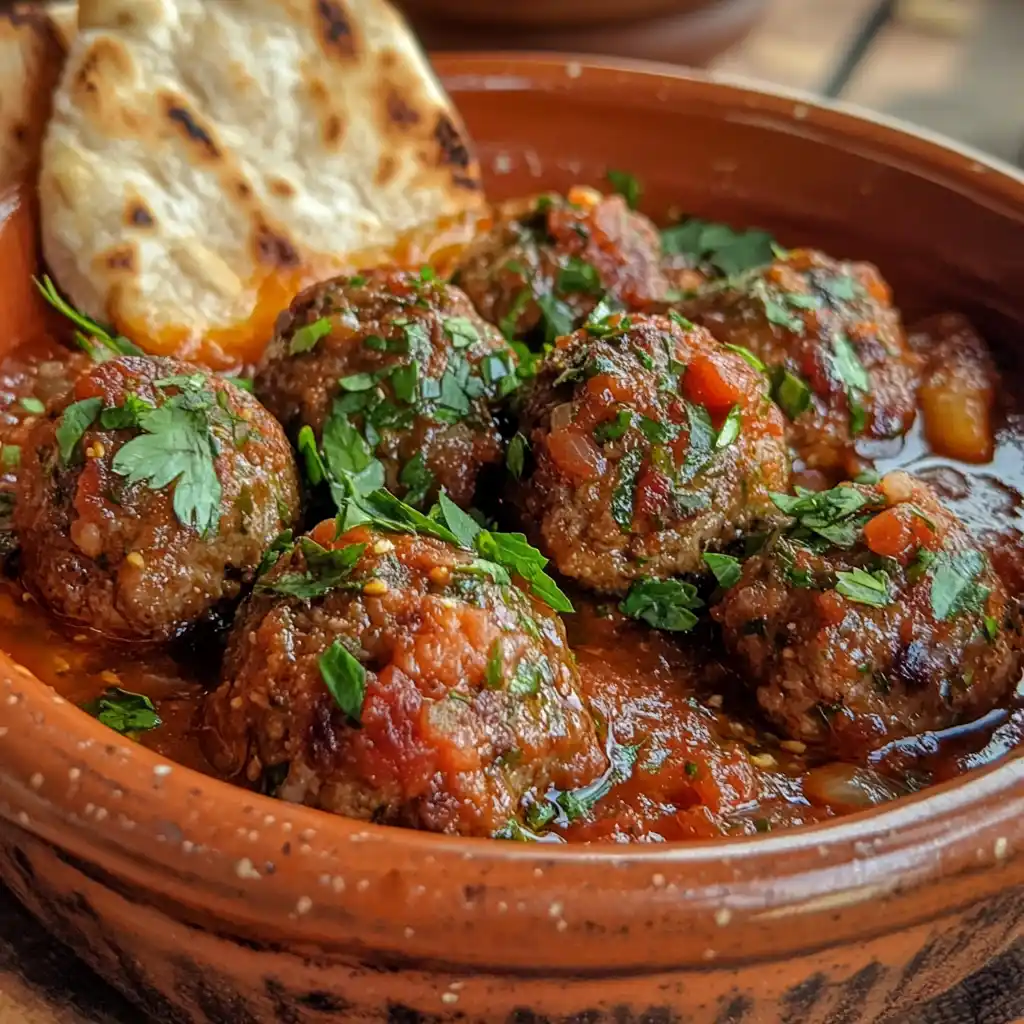Moroccan lamb meatballs are more than just a spiced twist on a classic favorite—they’re a vibrant, aromatic fusion of North African tradition and irresistible flavor. Whether you’re prepping for a family dinner or planning appetizers for a gathering, these meatballs bring depth, richness, and a warming aroma that instantly elevates any table. Infused with spices like cumin, cinnamon, and ras el hanout, and often served in a tangy tomato sauce or topped with mint yogurt, Moroccan lamb meatballs offer a savory, slightly sweet balance that satisfies a range of palates.
In this comprehensive guide, you’ll uncover the secrets behind this beloved dish—from selecting the best ingredients to mastering both traditional and modern cooking techniques. You’ll also learn how to pair them, store them, and even explore global variations. Whether you’re new to North African cooking or a seasoned home chef, this article delivers everything you need to perfect Moroccan lamb meatballs in your own kitchen.
Check out our own take on these richly spiced Moroccan Lamb Meatballs for a flavorful, home-cooked experience
Table of Contents
PART 1: Introduction to Moroccan Lamb Meatballs
What Makes Moroccan Lamb Meatballs Unique?
Moroccan lamb meatballs, often called kefta in Moroccan cuisine, are a staple dish that beautifully embodies the complexity of North African flavor profiles. Unlike your average meatballs, these are deeply aromatic and savory, built on a base of ground lamb infused with a medley of warming spices like cumin, coriander, cinnamon, and allspice. What really sets them apart is the signature Moroccan spice blend, ras el hanout, which can contain up to 30 different spices—making each bite an explosion of layered flavors.
These meatballs are also traditionally served in rich sauces that range from zesty tomato to sweet and tangy raisin-based reductions. Their textures are tender and juicy, thanks to a combination of minced onion, herbs, and sometimes breadcrumbs. You might find them nestled in tagines, folded into warm pitas, or served over fluffy couscous or rice. Their versatility in both flavor and form is what has made them a popular dish beyond Morocco’s borders.
How Moroccan Spices Elevate Lamb Meatballs
The real magic in Moroccan lamb meatballs lies in the spices. Moroccan cuisine is known for its artful use of seasoning, and these meatballs are no exception. The spices do more than just season the meat—they transform it.
Here’s a look at the most common spices used:
| Spice | Flavor Profile | Purpose in the Dish |
|---|---|---|
| Cumin | Earthy and slightly peppery | Balances the lamb’s gaminess |
| Cinnamon | Sweet and woody | Adds warmth and aromatic depth |
| Paprika | Mild and smoky | Enhances color and complexity |
| Coriander | Citrusy and nutty | Brightens the overall taste |
| Ras el Hanout | Complex spice blend | Signature Moroccan flavor |
| Cayenne Pepper | Hot and pungent | Adds subtle heat |
This rich layering of spices makes the meatballs not just savory, but deeply aromatic and comforting. When mixed properly with herbs like mint and parsley, and paired with a creamy yogurt or tomato-based sauce, they become truly unforgettable.
PART 2: Ingredients Breakdown for Authentic Moroccan Lamb Meatballs
Essential Spices: Ras el Hanout, Cumin, and More
At the heart of any authentic Moroccan lamb meatball recipe lies a well-balanced spice mix. While each household may have its own twist, certain spices are always present—each bringing unique flavor and depth.
Here’s a breakdown of the key spices that define the Moroccan profile:
- Ras el Hanout: This is the crown jewel of Moroccan spice blends. It translates to “head of the shop” and typically includes up to 30 spices like cardamom, clove, cinnamon, chili peppers, coriander, cumin, nutmeg, and turmeric. It’s what gives Moroccan lamb meatballs their signature warmth and complexity.
- Ground Cumin: Provides an earthy, nutty base that enhances lamb’s natural richness.
- Ground Coriander: Adds a hint of lemony brightness, perfect for balancing savory flavors.
- Smoked Paprika: Introduces a mild smoky undertone that deepens the flavor.
- Ground Cinnamon: Brings subtle sweetness and a warm aromatic note.
- Cayenne or Chili Flakes (optional): Used sparingly, this adds heat for those who enjoy a spicier bite.
Pro Tip: Toast whole spices and grind them yourself for maximum freshness and flavor impact.
Fresh Additions: Mint, Garlic, Onion, and Herbs

Spices may build the foundation, but the fresh ingredients are what bring moisture, texture, and aromatic lift to Moroccan lamb meatballs. Here’s what to include:
- Fresh Mint: Adds a cool contrast to the warm spices and complements the lamb perfectly.
- Fresh Parsley or Cilantro: Brings brightness and herbaceous notes.
- Grated Onion: Keeps the meatballs juicy and tender. The moisture from the onion helps bind the ingredients while boosting umami.
- Garlic: Finely minced for bold, punchy flavor that marries well with the spices.
- Egg: Acts as a binder, ensuring the meatballs hold their shape while staying tender.
- Breadcrumbs (optional): Used in some modern versions to add structure and softness.
The combination of these ingredients makes for a balanced and moist meatball, packed with flavor in every bite.
Choosing the Right Lamb for Juiciness and Flavor
Not all lamb is created equal when it comes to meatballs. Here’s how to choose the best:
- Use Ground Lamb with 15-20% Fat: This ratio ensures the meatballs stay juicy and rich. Too lean and they’ll dry out.
- Fresh Over Frozen: Always go with fresh ground lamb if possible. Frozen lamb can have excess moisture and a tougher texture.
- Ask Your Butcher: If you want high-quality lamb, ask your butcher to grind it fresh. A mix of shoulder and leg meat works beautifully.
PART 3: How to Make Moroccan Lamb Meatballs Step-by-Step
Preparing the Meatball Mixture
Creating flavorful Moroccan lamb meatballs starts with a well-balanced and well-blended mixture. Here’s how to get the perfect texture and taste every time:
Step-by-Step Instructions:
- Gather Your Ingredients:
- 1 lb ground lamb (preferably 15-20% fat)
- 1 small onion, finely grated
- 2–3 garlic cloves, minced
- 1 tablespoon fresh chopped mint
- 2 tablespoons chopped parsley or cilantro
- 1 egg
- ¼ cup breadcrumbs (optional for structure)
- 1 teaspoon ground cumin
- 1 teaspoon ras el hanout
- ½ teaspoon ground coriander
- ½ teaspoon paprika
- ¼ teaspoon ground cinnamon
- Pinch of cayenne (optional)
- Salt and black pepper to taste
- Mix Gently:
Combine all ingredients in a large mixing bowl. Use your hands or a fork to gently mix until evenly distributed, but don’t overwork the mixture—this can make the meatballs tough. - Chill the Mixture (Optional but Recommended):
Cover and refrigerate for 20–30 minutes. This allows the flavors to meld and makes the mixture easier to shape. - Shape into Balls:
Roll the mixture into meatballs about 1 to 1.5 inches in diameter. Keep them uniform for even cooking.
Shaping, Searing, and Cooking Techniques
There are a few popular methods to cook Moroccan lamb meatballs depending on the texture and presentation you’re aiming for. Each offers its own benefits:
1. Pan-Frying (Traditional)
- Heat a little olive oil in a heavy-bottomed skillet over medium heat.
- Sear the meatballs for 2–3 minutes per side until browned all over.
- Remove and drain excess oil on paper towels.
- Often, they’re finished by simmering in sauce (see Part 4).
2. Baking (Healthier Option)
- Preheat oven to 400°F (200°C).
- Place meatballs on a parchment-lined baking tray.
- Bake for 18–22 minutes or until cooked through.
- Flip once halfway for even browning.
3. Tagine Cooking (Authentic Moroccan Method)
- Sear meatballs lightly, then add to a tagine with a simmering sauce.
- Cover and cook gently for 20–30 minutes until the flavors meld.
Each cooking method lends a slightly different finish—from crisp edges to melt-in-your-mouth softness—so you can choose based on your preference or available time.
PART 4: Exploring Moroccan Lamb Meatball Sauces
Tomato-Based Sauce with Sweet Raisins
One of the most beloved ways to serve Moroccan lamb meatballs is by simmering them in a rich, spiced tomato sauce. This classic pairing not only infuses the meatballs with additional flavor but also creates a luscious base perfect for serving with couscous, rice, or bread.
How to Make It:
Ingredients:
- 1 tablespoon olive oil
- 1 small onion, finely chopped
- 2 garlic cloves, minced
- 1 teaspoon ground cumin
- ½ teaspoon ground cinnamon
- 1 can (15 oz) crushed tomatoes
- ¼ cup golden raisins
- 1 teaspoon ras el hanout
- Salt and pepper to taste
- Fresh cilantro or parsley for garnish
Instructions:
- In a skillet, heat olive oil and sauté onion until translucent.
- Add garlic, cumin, cinnamon, and ras el hanout. Stir until fragrant.
- Pour in crushed tomatoes and raisins. Simmer for 10–15 minutes until slightly thickened.
- Add pre-cooked meatballs to the sauce. Cover and simmer for another 15 minutes to allow flavors to meld.
- Garnish with chopped herbs and serve hot.
This sauce delivers a beautiful balance of sweet, savory, and spiced elements. The raisins plump up in the tomato base, adding a gentle sweetness that’s iconic in Moroccan cuisine.
Mint Yogurt Sauce and Harissa Tomato Sauce
For lighter or fusion-style dishes, yogurt-based and harissa-infused sauces offer excellent variety. Each works well for different serving methods—whether you’re going for a party platter, pita wrap, or a healthier meal.
Mint Yogurt Sauce:
Perfect as a dip or drizzle, this sauce is cooling, tangy, and balances the spices of the meatballs.
Ingredients:
- 1 cup plain Greek yogurt
- 1 tablespoon fresh mint, finely chopped
- 1 small garlic clove, grated
- 1 tablespoon lemon juice
- Salt to taste

How to Use:
Serve alongside meatballs in wraps or bowls. Works great cold for contrast.
Harissa Tomato Sauce:
This fiery, deep red sauce brings bold heat and intense flavor. Harissa is a North African chili paste that pairs naturally with lamb.
Quick Recipe:
- Blend 1 tablespoon harissa paste with 1 cup tomato purée, a touch of olive oil, and garlic. Simmer for 10 minutes and pour over baked or pan-fried meatballs.
Sauce transforms this dish from simple to spectacular. Whether you’re in the mood for a comforting stew or a fresh appetizer, there’s a Moroccan sauce that brings your lamb meatballs to life.
PART 5: Traditional and Modern Cooking Methods
Skillet, Baked, and Tagine Options
Moroccan lamb meatballs are as versatile in the kitchen as they are flavorful. Depending on your time, kitchen setup, or health preferences, there are multiple cooking methods to choose from—each creating a distinct texture and finish.
1. Skillet-Fried (Traditional & Flavorful)
The most authentic Moroccan approach involves pan-frying the meatballs before simmering them in sauce.
Steps:
- Heat 2 tablespoons olive oil in a non-stick or cast-iron skillet over medium-high heat.
- Place meatballs in a single layer, making sure they don’t touch.
- Fry for 2–3 minutes per side until all sides are browned.
- Transfer them into a sauce or tagine to finish cooking.
Pros: Deep flavor from caramelized exterior.
Best For: Serving in rich sauces or over grains like couscous.
2. Baked (Easy & Healthier)
If you’re cooking for a crowd or want a leaner version, baking is an excellent choice.
Steps:
- Preheat oven to 400°F (200°C).
- Place meatballs on a foil or parchment-lined baking tray.
- Bake for 18–22 minutes, flipping halfway through for even browning.
Pros: Less oil, easy cleanup.
Best For: Pairing with dips or serving in wraps.
3. Tagine (Authentic Moroccan Method)
Cooking meatballs in a traditional tagine allows them to absorb deep flavors from the sauce as they steam gently.
Steps:
- After lightly searing meatballs, transfer them to a tagine.
- Add sauce (tomato-raisin or harissa tomato).
- Cover and simmer over low heat for 30–40 minutes.
Pros: Infuses meatballs with moisture and spices.
Best For: Rich, sit-down meals with traditional presentation.
Slow-Cooked vs Quick Pan-Fried Techniques
The method you choose doesn’t just affect cooking time—it influences taste, texture, and how the dish is perceived.
| Method | Time | Texture | Best For |
|---|---|---|---|
| Pan-Fried + Sauce | 30–40 minutes | Crisp outside, juicy inside | Classic Moroccan presentation |
| Baked | 20–25 minutes | Evenly cooked, lighter feel | Meal prep, wraps, dipping |
| Tagine | 60 minutes+ | Ultra-tender, infused | Authentic, rich family meals |
Each technique brings something unique to the table, so don’t be afraid to try a few to discover your favorite.
Looking for inspiration? Try this quick and healthy Chicken Stir Fry as another globally inspired dish you can whip up in under 30 minutes.
PART 6: Best Ways to Serve Moroccan Lamb Meatballs
Pairings: Couscous, Flatbread, and Salads
The beauty of Moroccan lamb meatballs lies not only in their rich flavor but also in their adaptability. They can take center stage in hearty meals or complement lighter fare—depending on how you serve them.
1. Over Couscous or Rice
Couscous is the traditional Moroccan accompaniment for lamb meatballs. The small granules soak up the flavorful sauces beautifully and add lightness to the dish.
Couscous Serving Tips:
- Fluff couscous with a fork after steaming.
- Add chopped herbs, lemon zest, or toasted almonds for extra flavor.
Alternative: Serve over a bed of fluffy basmati or saffron rice.
2. With Warm Flatbreads or Pitas
For a street-food-style option, serve the meatballs inside warm pita pockets or folded flatbreads.
Add-ins:
- Cucumber slices
- Red onion rings
- Mint yogurt or tahini sauce
- Pickled carrots or cabbage
This is a crowd-pleasing choice for parties, casual dinners, or lunch prep.
3. On Fresh Salads
Balance the richness of the lamb with fresh greens and crisp vegetables.
Salad Ideas:
- Arugula, cucumber, and cherry tomatoes
- Lemon vinaigrette or yogurt dressing
- Toasted pine nuts for crunch
This makes for a lighter, low-carb option that still satisfies.
Stuffing in Pita vs Over Pilaf or Rice
Whether you prefer hand-held or plated meals, Moroccan lamb meatballs adapt seamlessly:
Stuffing in Pita:
- Best for picnics, parties, or on-the-go meals.
- Use smaller meatballs, and don’t forget sauces like mint yogurt or harissa aioli.
Serving Over Pilaf or Rice:

- Ideal for dinners and formal meals.
- Pilaf with raisins, almonds, and spices mirrors Moroccan tradition.
- Pairs wonderfully with a drizzle of sauce and fresh herb garnish.
| Serving Style | Setting | Suggested Sides |
|---|---|---|
| Pita Wrap | Casual / Street | Yogurt sauce, veggies |
| Couscous Bowl | Traditional | Tomato sauce, roasted carrots |
| Salad Plate | Light Lunch | Lemon vinaigrette, arugula |
| Pilaf Platter | Dinner Party | Harissa sauce, flatbread |
Don’t miss our creamy and comforting Broccoli Cheese Casserole, another crowd-pleasing recipe to serve alongside these flavorful lamb meatballs.
PART 7: Nutrition, Storage, and Make-Ahead Tips
Nutritional Breakdown per Serving
Moroccan lamb meatballs may be rich in flavor, but when prepared thoughtfully, they can also be part of a balanced diet. Here’s a general breakdown for a serving size of 4–5 medium meatballs (without sauce):
| Nutrient | Approximate Amount |
|---|---|
| Calories | 290–320 kcal |
| Protein | 20–22 grams |
| Total Fat | 22–25 grams |
| Saturated Fat | 9–10 grams |
| Carbohydrates | 3–6 grams |
| Fiber | 0.5–1 gram |
| Sugar | 1–2 grams |
| Sodium | 400–500 mg |
Adding a tomato-based or yogurt sauce will increase the nutritional content slightly, especially sodium and fat (in the case of creamy sauces). You can adjust this by choosing leaner cuts of lamb or reducing added salt and oil.
Freezing and Reheating Without Losing Flavor
Moroccan lamb meatballs are a dream for batch cooking and meal prep. They freeze well and reheat without losing moisture or flavor—perfect for busy nights or entertaining.
Freezing Tips:
- Uncooked Meatballs: Shape and lay flat on a parchment-lined tray. Freeze for 1–2 hours until solid, then transfer to a freezer bag. Use within 2–3 months.
- Cooked Meatballs: Let them cool fully. Store in an airtight container or vacuum-seal in sauce for maximum flavor retention.
Reheating Methods:
| Method | Instructions |
|---|---|
| Stovetop | Simmer frozen or thawed meatballs in sauce until heated through. |
| Oven | Bake at 350°F (175°C) for 15–20 minutes, covered with foil. |
| Microwave (for small portions) | Use a microwave-safe dish with a lid, heat in 30-second intervals. |
Make-Ahead Meal Prep Ideas:
- Meal Bowls: Portion meatballs with couscous and roasted veggies.
- Party Skewers: Reheat and skewer with cherry tomatoes and olives for easy appetizers.
- Wrap Kits: Pre-pack pitas, yogurt sauce, and fresh greens with meatballs for easy assembly.
Maintaining flavor during storage is all about sealing in moisture and reheating gently. Moroccan lamb meatballs are incredibly freezer-friendly when cooked or raw, making them a smart choice for efficient, flavorful meal planning
Looking for a quick lunch meal prep idea? This High Protein Egg Salad Sandwich makes an excellent make-ahead option, just like our Moroccan meatballs.
PART 8: Moroccan Lamb Meatballs Around the World
Global Variations and Cultural Twists
While Moroccan lamb meatballs (kefta) have deep roots in North African culinary tradition, their popularity has led to global reinventions that honor the original while adding new cultural flair. From Mediterranean kitchens to upscale Western restaurants, chefs are putting their own spin on this timeless dish.
Mediterranean & Middle Eastern Fusion
In neighboring regions like Lebanon, Turkey, and Greece, lamb meatballs adopt local spices and serving styles:
- Lebanese-style kefta: Often grilled and served with tabbouleh or garlic yogurt sauce.
- Turkish köfte: Typically shaped into oblong patties and served with sumac onions.
- Greek lamb meatballs (Keftedes): Include oregano and are often paired with tzatziki.
Each variation maintains the core lamb + spice identity while tailoring the herbs and cooking methods to regional preferences.
European & American Interpretations
In modern kitchens, Moroccan lamb meatballs are now featured in:
- Gourmet Sliders: Tucked into mini brioche buns with harissa mayo.
- Tapas Menus: Paired with smoky eggplant dip or za’atar flatbread.
- Bowl Meals: Served over quinoa with kale and lemon tahini.
Restaurants often soften the spice mix for broader appeal but maintain the ras el hanout and mint as flavor anchors.
Fusion Recipes and Restaurant-Inspired Ideas
The adaptability of Moroccan lamb meatballs lends itself well to innovation. Here are a few creative ideas you can try at home:
| Fusion Dish | Inspiration | Serving Notes |
|---|---|---|
| Moroccan Lamb Tacos | Mexican | Use grilled lamb meatballs in corn tortillas with pickled onions. |
| Harissa Spaghetti & Meatballs | Italian x North African | Toss baked lamb meatballs in harissa-infused tomato sauce over pasta. |
| Moroccan Meatball Pizza | American | Top flatbread with tomato sauce, meatballs, feta, and olives. |
| Lamb Meatball Grain Bowl | California Fusion | Serve with farro, hummus, greens, and lemon dressing. |
These creative approaches show how flexible the dish can be, making it a perfect canvas for both traditionalists and food explorers alike.
FAQs About Moroccan Lamb Meatballs
What are Moroccan meatballs made of?
What sauce goes with Moroccan meatballs?
What is the sauce for Moroccan lamb?
How to make Moroccan lamb mince?
Start with 1 lb ground lamb.
Add grated onion, minced garlic, and fresh parsley or mint.
Mix in spices: 1 tsp cumin, 1 tsp ras el hanout, ½ tsp cinnamon, salt, and pepper.
Optional: Add 1 egg and ¼ cup breadcrumbs for binding.
Combine gently and use it to shape meatballs, patties, or use in tagines.
This seasoned mince can be used in meatballs, kebabs, or stuffed into vegetables for versatile Moroccan-inspired dishes
Conclusion: Bringing Moroccan Lamb Meatballs to Your Table
Moroccan lamb meatballs are a celebration of spice, warmth, and versatility. Whether you’re simmering them in a rich tomato-raisin sauce, pairing them with mint yogurt in a pita, or serving them over couscous with fresh greens, this dish brings a satisfying blend of tradition and adaptability. The careful balance of ras el hanout, fresh herbs, and quality ground lamb makes every bite an aromatic delight.
From weeknight dinners to entertaining guests, Moroccan lamb meatballs deliver flavor, ease, and cultural depth. Their global appeal has inspired modern takes, but the heart of this dish always lies in its grounding in Moroccan spice mastery. Whether baked, pan-fried, or slow-cooked in a tagine, these meatballs are an easy gateway to exploring the richness of Moroccan cuisine.
.

